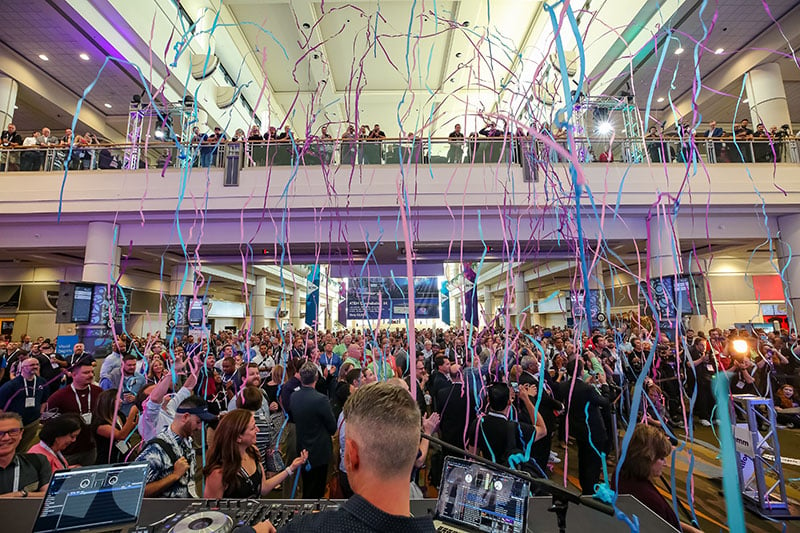Iconic Washington Monument Becomes an Audiovisual Canvas for Apollo 50 Celebration
What sight could possibly bring a slew of visitors and Washington, D.C. locals together on the National Mall in the middle of a record-setting heatwave? A celebration of man’s first visit to the moon and the promise of seeing the capital city’s beloved Washington Monument completely transformed.
To celebrate the Apollo 11 moon mission’s 50-year anniversary, the Smithsonian National Air and Space Museum commissioned the immersive projection show Apollo 50: Go for the Moon from 59 Productions, a multi-award-winning London-based design studio and production company comprised of technologists and designers specializing in immersive live experiences. The show endeavored to recreate the sense of bravado and patriotism people felt at that pivotal moment in history.
Richard Slaney, Managing Director of 59 Productions, explains the initiation of the project, “they phoned us up and said, ‘could you project on something that’s 500 feet high?’” He immediately knew what that must be referring to: The Washington Monument. The team quickly mobilized for the feat of producing an immersive audiovisual experience on one of the tallest structures in Washington.
The Team
It took more than 400,000 people from all 50 U.S. states to make the Apollo moon mission a reality in 1969. So, it was fitting that to make this commemorative project come to life, the Smithsonian’s National Air and Space Museum enlisted a large team of talented individuals who put their resources, heads, and hearts into the project. More than a year of planning went into this one-week production on the National Mall and the Washington Monument. The Smithsonian had to get a joint resolution of U.S. Congress passed and approval from the Office of the President to allow this to happen. See it online here. Boeing and Raytheon were brought on board as financial sponsors.
Slaney, director of Apollo 50: Go for the Moon, had a clear mission to create a 363-foot projection of the Saturn V rocket. 59 Productions also managed the technical side onsite with a team of 15 who took turns working night shifts for two weeks. They waited for the city to sleep in order to preview the visual component. No audio was previewed, because as Slaney said, they “didn’t want to give too much away.”
The Tech
The projection began Tuesday night, July 16, with a static image of the 363-foot-tall Saturn V rocket on the east face of the monument from 9:30 p.m. to 11:30 p.m. The big spectacle took place at 9:30 p.m., 10:30 p.m., and 11:30 p.m. Friday, July 19 and Saturday, July 20.
During the Friday and Saturday night displays, the projection was accompanied by a 17-minute video comprised of mostly archival footage on two giant digital video screens. It led us through President John F. Kennedy’s 1962 “we go to the moon” speech to the impending Artemis mission with a captivating musical score. The footage was heightened and brought to life with massive set of subwoofers that shook the National Mall.
While most of the video on the screens was archival footage, the monument projections were comprised of CG recreations. The difficulty for the team laid in the pixel ratio of the monument’s obelisk shape, which is over 8000 pixels tall and 900 pixels wide. Slaney stated in a Studiodaily interview “It’s a pretty big resolution, and a pretty weird aspect ratio. But the building texture and color really help to just soften the CG look in a way that makes it really readable.”
With the outdoor elements and natural halo of the city, no shortcuts could be taken with the projector systems put in place. An army of quality contrast projectors would be needed to contrast said elements. The gear rental was provided by DWP Live, a Nashville company specializing in rentals in projection-mapping gear and integrations. Out of the 32 30,000 lumen Barco laser projectors, 24 were secured at the base of the monument, and as Slaney explains, the remaining eight projectors were positioned front-of-house. All projectors fed through a media-server software from Disguise.
The Mission
The 59 Productions team had one shot for audio and visual to come together for this once in a lifetime immersive, ground shaking, projection experience.
The anticipation heightened as the entire team watched the full production of Apollo 50: Go for the Moon for the first time at Friday’s public showing at the same time as the general public in attendance. For the first time, the audio and visual components conjoined and far exceeded expectations, just as the predicted attendance number of 150,000 — the Smithsonian National Air and Space Museum estimated that nearly half a million people filled the National Mall to watch the tale unfold over the weekend. “The first time we did sound and picture was show one, about an hour ago,” Slaney shared on Friday night.
When it was all said and done, as the rocket launched, moved by subwoofers and Kennedy’s words, and revealed Neil Armstrong’s boot print on the extraterrestrial surface, it compelled the crowd to burst into applause, as if they were watching it happen for the first time. To say that it was moving would be doing it disservice. Dare I say, it was out-of-this-world to hear and see audio and visual come together and project millions of Americans back to the moment when the moon mission was what mattered. As Kennedy in 1962 famously puts, “because that challenge is one that we are willing to accept, one we are unwilling to postpone, and one which we intend to win.”
Watch the full interview with Richard Slaney, which was recorded minutes after the second full show launched.






